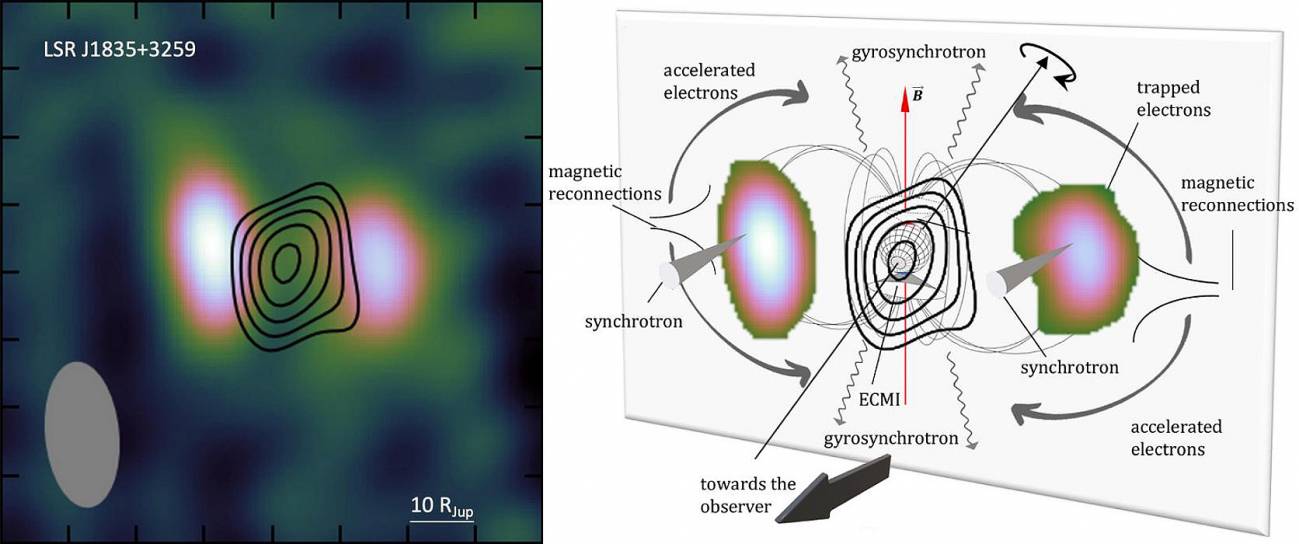The first detailed image of a radiation belt outside the Solar System is obtained
It has been detected around a brown dwarf, a type of cold, low-mass substar. Published in Science, the image evokes the well-known belts of the Earth and Jupiter and reveals a magnetic field ten times greater than that of Jupiter, as well as intense polar auroras
In 1958, scientist James Van Allen discovered that planet Earth was surrounded by ions and electrons trapped in the Earth's magnetic field, which interfered with communications with space probes. Almost simultaneously, giant radiation belts around Jupiter were discovered from bursts detected in radio observations. Now, an international scientific team with the participation of the Institute of Astrophysics of Andalusia (IAA-CSIC) has found and described in detail for the first time a radiation belt outside our Solar System, not on a planet but on a brown dwarf, a gaseous object that never developed the nuclear reactions that define the stars and that occupies a mass range between the most massive gaseous planets and the lightest stars.
The donut-shaped radiation belt found in the brown dwarf LSR J1835 is almost a scale version of the Van Allen belts around our planet and Jupiter. “Although with a different size and energy, this similarity is evident when the radiation belts of Jupiter and LSRJ1835 are observed together,” says Juan Bautista Climent, researcher at the University of Valencia and the International University of Valencia and first author of the paper.
“The diameter of the magnetic structure around this ultracold dwarf is ten times larger than that of Jupiter and millions of times more powerful”, he adds. “In reality, LSRJ1835 is sixty times more massive than this gas giant and spins three times as fast. Both facts combine to create an intense magnetic field on its surface, very similar to that irradiated in a magnetic resonance device".
To image its radiation belt, the European VLBI network combined giant radio antennas spread across the planet, from Spain to China, from Sweden to South Africa. All of them have scanned the brown dwarf simultaneously to achieve a resolution fifty times better than that of the James Webb Space Telescope.

Very luminescent auroras
The extraordinary detail of the radio image of LSRJ1835 has also revealed that, as on Earth and Jupiter, the radiation belt contributes to the formation of auroras. “These auroras release energy in a very concentrated manner and at very high temperatures, and produce radio emission peaks ten times greater than the total emission of LSRJ1835”, says co-author José Carlos Guirado, professor of Astronomy at the University of Valencia.
Both the aurora and the radiation belt can be observed simultaneously, providing valuable information about the geometry of the brown dwarf. The study suggests that ultracold dwarfs that emit radio have magnetic fields arranged by dipoles with morphologies and auroras similar to those of gas giants like Jupiter.
The new radiation belt of LSRJ1835 has been observed at radio wavelengths by the European Very Long Baseline Interferometry (VLBI) network. LSRJ1835 is a brown dwarf, a transitional body between a star and a planet, located eighteen light-years away. It is an extremely small body and only the use of such instruments allows a detailed view of its environment.
These results demonstrate that the European VLBI network is capable of mapping radiation belts on nearby objects, and anticipate that future instruments, such as the Square Kilometre Array, will extend these studies to smaller and more remote objects, including exoplanets.
Knowledge of the magnetic environment of exoplanets is extremely important for gauging the chances of harbouring extraterrestrial life. "Whether life is viable depends to a large extent on the characteristics of the radiation surrounding these new worlds", says Miguel Ángel Pérez-Torres, a researcher at the Instituto de Astrofísica de Andalucía (IAA-CSIC) who participates in the study.
J. B. Climent, J. C. Guirado, M. Pérez-Torres, J. M. Marcaide, L. Peña-Moñino, “Evidence for a radiation belt around a brown dwarf”. Science, DOI: 10.1126/science.adg6635
Instituto de Astrofísica de Andalucía (IAA-CSIC)
Unidad de Divulgación y Comunicación
Silbia López de Lacalle - sll[arroba]iaa.es - 958230676
https://www.iaa.csic.es
https://divulgacion.iaa.csic.es

